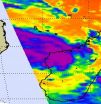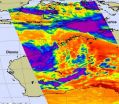(Press-News.org) VIDEO:
Nobody enjoys colonoscopies, including mice. University of Missouri researchers are excited about the potential of using genetic biomarkers to predict colon cancer caused by inflammation. A new method developed at...
Click here for more information.
COLUMBIA, Mo. – Nobody enjoys colonoscopies, including mice. University of Missouri researchers are excited about the potential of using genetic biomarkers to predict colon cancer caused by inflammation. A new method developed at the MU Research Animal Diagnostic Laboratory (RADIL) could eventually lead to a method that might eliminate colonoscopies altogether.
While working to develop novel therapeutics for colon cancer, Craig Franklin, associate professor of veterinary pathobiology in the MU College of Veterinary Medicine; Aaron Ericsson, post-doctoral researcher at MU; Mike Lewis, assistant professor of veterinary medicine and surgery; Matt Myles, assistant professor of veterinary pathobiology and Lillian Maggio-Price, professor of comparative medicine at the University of Washington, found biomarkers in mouse feces that predicted inflammation-associated colon cancer. This is the same type of cancer associated with some common inflammatory bowel diseases such as ulcerative colitis and Crohn's Disease.
The team found that the bacterium that leads to inflammation-associated colon cancer in mice first results in inflammation that can be detected by screening feces for messenger RNA of genes. Franklin believes this discovery could lead to tests for similar genes that are present in humans with early inflammation associated colon cancer.
The study was published recently in Neoplasia, which also featured the study on the journal's cover.
"The assumption was that the gene expression couldn't be detected in fecal matter because RNA breaks down very rapidly. Historically, this was something that a lot of scientists, including us, hadn't considered," Franklin said. "But technology has evolved, and we now have the means of preserving RNA much better than we did 15 years ago."
As a laboratory animal veterinarian, Franklin believes this discovery also could decrease the number of animals used in research.
"We're excited about the potential for application in humans, but this also will decrease animal numbers, which is one of our goals," Franklin said. "This test determines which mice will get cancer in advance, so we won't need to have as many animals in an experimental group to achieve statistical significance."
"There's also no stress on the animal for us to test their fecal matter," Ericsson said. "Many people put off colonoscopies longer than they should because of the invasiveness and unpleasant nature of the exam, and it's not pleasant for mice either. That unpleasantness is negated with this test."
For this study, the team also used a high-powered MRI machine located in the Department of Veterans Affairs facility located at the Harry S. Truman Memorial Veterans' Hospital. While effective, this technique was not as sensitive as the fecal biomarkers in predicting cancer, and it requires extensive expertise and very expensive equipment. Franklin credits the success of the project to a multidisciplinary team that included Wade Davis, assistant professor of biostatistics; Lixin Ma, assistant professor of radiology, and a multitude of veterinarians.
"It was a large collaboration, and veterinarians are ideal for collaborative medicine because we know the animal model," Franklin said. "There are several angles that converge here, and we're now interested in finding collaborators in human medicine that would like to explore this further. Ultimately, I'd envision panels of tests that predict diseases, with this method in the mix."
### END
MU researchers believe discovery could lead to testing that displaces colonoscopies
Predicting colon cancer in mice could eventually benefit humans
2011-02-17
ELSE PRESS RELEASES FROM THIS DATE:
Most New Jersey residents see global health as critical to state's economy
2011-02-17
WASHINGTON—February 16, 2011—Despite the unpredictable economy, nearly three-quarters (73%) of New Jersey residents think spending money on research to improve health globally is important to jobs and incomes in the state, according to a new statewide poll commissioned by Research!America. The poll data will be released today at a meeting in Washington, DC, of prominent global health research and development (R&D) experts and New Jersey business, academia and nonprofit leaders. This is part of a six-state effort by Research!America.
According to the poll, most of the ...
California Health Interview Survey releases newest data on state residents' health
2011-02-17
The California Health Interview Survey (CHIS), the nation's largest state health survey and a primary source of information on California's diverse population, released its latest data today on more than 100 topics affecting the health and well-being of the state's residents.
The random–digit-dial telephone survey, conducted every two years by the UCLA Center for Health Policy Research, gathers essential information from tens of thousands of California households on a wide variety of topics, from health insurance and public program participation to diabetes, obesity ...
NASA satellite sees Tropical Storm Bingiza hugging the western Madagascar coastline
2011-02-17
Infrared satellite data from NASA is showing some strong thunderstorms over west-central Madagascar today as Tropical Storm Bingiza continues to hug the western coast of the island nation.
The Atmospheric Infrared Sounder (AIRS) instrument that flies aboard NASA's Aqua satellite captured an infrared image of Tropical Storm Bingiza today, Feb. 16 at 10:17 UTC (5:17 a.m. EST). The image revealed some strong convection over the west-central coast where thunderstorm cloudtops were high and dropping moderate to heavy rainfall. Infrared data can provide temperature information ...
NASA sees tropical cyclone double-trouble for Australia
2011-02-17
NASA's Aqua satellite captured an infrared image today of tropical cyclones affecting Australia in the western and northern areas of the country. Newly formed Tropical Storm Carlos is bringing heavy rains and gusty winds to Darwin and the Northern Territory, while Tropical Storm Dianne is bringing rains and winds to Western Australia.
NASA's Aqua satellite passed over Australia today, Feb. 16 at 05:17 UTC (12:17 a.m. EST/ 2:47 p.m. Australia/Darwin local time. The Atmospheric Infrared Sounder (AIRS) instrument captured an infrared image of both tropical storms and found ...
Herschel finds less dark matter but more stars
2011-02-17
ESA's Herschel space observatory has discovered a population of dust-enshrouded galaxies that do not need as much dark matter as previously thought to collect gas and burst into star formation.
The galaxies are far away and each boasts some 300 billion times the mass of the Sun. The size challenges current theory that predicts a galaxy has to be more than ten times larger, 5000 billion solar masses, to be able form large numbers of stars.
The new result is published today in a paper by Alexandre Amblard, University of California, Irvine, and colleagues.
Most of the ...
Trial suggests statin may affect markers associated with progression of HIV
2011-02-17
A recent multicenter clinical trial of atorvastatin, a type of cholesterol-lowering drug, found that although the drug did not inhibit plasma HIV RNA levels, it did inhibit expression of cellular markers of immune activation and inflammation in patients with HIV infection. Since immune activation and inflammation are associated with progression of HIV infection, the implication is that the statin may inhibit disease progression and help in the infection's management. The findings are in a study, available online, published in The Journal of Infectious Diseases.
The investigators, ...
New test shows promise for accurate diagnosis of Turner syndrome
2011-02-17
As a child grows, a short stature is not usually cause for concern, but it is often the only sign of a condition called Turner syndrome. Prevalent in girls, Turner syndrome is a genetic defect that short-circuits normal growth and leads to cardiac and renal problems. It is not commonly detected until age 10 or older when a youngster's unusually short height raises suspicions.
This lag before diagnosis of the condition can delay the start of growth hormone therapy, which can help in achieving normal or near-normal adult stature. Yale School of Medicine researchers are ...
Drug therapy shows significant benefit in treating a leading cause of childhood blindness
2011-02-17
A readily available, inexpensive drug therapy showed a significant benefit in treating premature infants with the worst and historically most difficult-to-treat cases of retinopathy of prematurity.
The results of a multicenter clinical trial led by researchers at The University of Texas Health Science Center at Houston (UTHealth) are published in the Feb. 17 issue of The New England Journal of Medicine.
Retinopathy of prematurity is a leading cause of childhood blindness worldwide. In the immature retina of babies born before 30 weeks' gestational age, the disease results ...
Research improves diagnosis and treatment of bleeding disorder
2011-02-17
A rare bleeding disorder that can lead to life-threatening bleeding episodes is misdiagnosed in 15 per cent of cases according to findings from a new international research project led by a Queen's professor.
"Correct diagnosis is critical because it determines the treatment decision," says Maha Othman, a professor in the Department of Anatomy and Cell Biology who led the three-year research project on the rare platelet type of von Willebrand disease (VWD).
Patients with VWD are commonly treated with drugs that help control their condition. However, these drugs aggravate ...
Global warming may reroute evolution
2011-02-17
ANN ARBOR, Mich.---Rising carbon dioxide levels associated with global warming may affect interactions between plants and the insects that eat them, altering the course of plant evolution, research at the University of Michigan suggests.
The research focused on the effects of elevated carbon dioxide on common milkweed, Asclepias syriaca. Milkweed is one of many plants that produce toxic or bitter chemical compounds to protect themselves from being eaten by insects. These chemical defenses are the result of a long history of interactions between the plants and insects ...
LAST 30 PRESS RELEASES:
Making lighter work of calculating fluid and heat flow
Normalizing blood sugar can halve heart attack risk
Lowering blood sugar cuts heart attack risk in people with prediabetes
Study links genetic variants to risk of blinding eye disease in premature infants
Non-opioid ‘pain sponge’ therapy halts cartilage degeneration and relieves chronic pain
AI can pick up cultural values by mimicking how kids learn
China’s ecological redlines offer fast track to 30 x 30 global conservation goal
Invisible indoor threats: emerging household contaminants and their growing risks to human health
Adding antibody treatment to chemo boosts outcomes for children with rare cancer
Germline pathogenic variants among women without a history of breast cancer
Tanning beds triple melanoma risk, potentially causing broad DNA damage
Unique bond identified as key to viral infection speed
Indoor tanning makes youthful skin much older on a genetic level
Mouse model sheds new light on the causes and potential solutions to human GI problems linked to muscular dystrophy
The Journal of Nuclear Medicine ahead-of-print tip sheet: December 12, 2025
Smarter tools for peering into the microscopic world
Applications open for funding to conduct research in the Kinsey Institute archives
Global measure underestimates the severity of food insecurity
Child survivors of critical illness are missing out on timely follow up care
Risk-based vs annual breast cancer screening / the WISDOM randomized clinical trial
University of Toronto launches Electric Vehicle Innovation Ontario to accelerate advanced EV technologies and build Canada’s innovation advantage
Early relapse predicts poor outcomes in aggressive blood cancer
American College of Lifestyle Medicine applauds two CMS models aligned with lifestyle medicine practice and reimbursement
Clinical trial finds cannabis use not a barrier to quitting nicotine vaping
Supplemental nutrition assistance program policies and food insecurity
Switching immune cells to “night mode” could limit damage after a heart attack, study suggests
URI-based Global RIghts Project report spotlights continued troubling trends in worldwide inhumane treatment
Neutrophils are less aggressive at night, explaining why nighttime heart attacks cause less damage than daytime events
Menopausal hormone therapy may not pose breast cancer risk for women with BRCA mutations
Mobile health tool may improve quality of life for adolescent and young adult breast cancer survivors
[Press-News.org] MU researchers believe discovery could lead to testing that displaces colonoscopiesPredicting colon cancer in mice could eventually benefit humans




